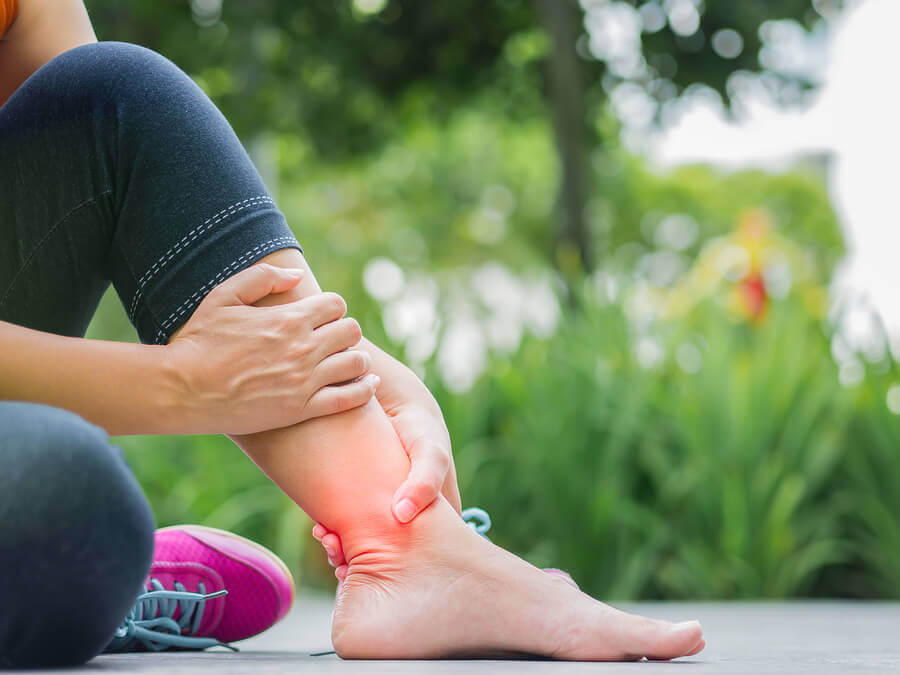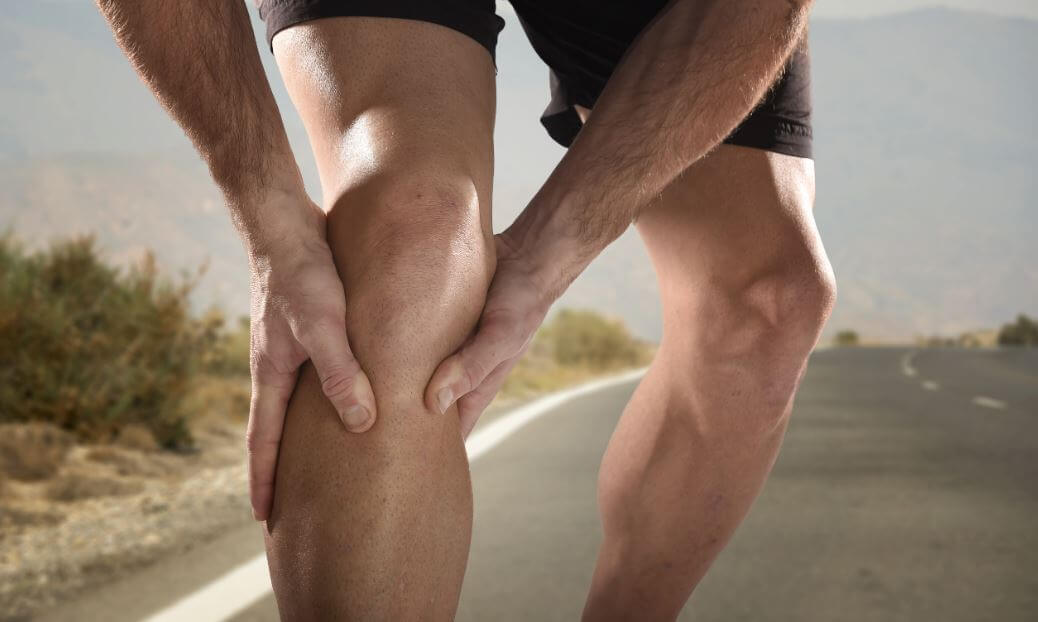Common Leg Injuries

Athletes, or anyone who exercises regularly, constantly risk leg injuries that can threaten their physical performance. If that’s you, you should be aware of the most common injuries and how to prevent them.
Legs are crucial for actions such as standing, walking, running and more. Thus, taking care of them is an important part of overall well-being.
An injury is an alteration or wound that occurs on your body as a result of an impact, an accident, a sickness, use, and other causes. Play it safe with injuries because many of them require specialized medical attention.
Five common leg injuries
Your legs carry your body-weight and handle the impact of different exercises. As a result, over time certain sports injuries commonly affect these lower limbs.
1. Sprained ankle
Sprained ankles are more common than you might imagine in all athletes. Sprains occur when the foot bends inwards, pulling the ankles’ ligaments more than normal. As a consequence, the ligaments tear.
Ankle sprains can happen in many situations such as running on unstable terrain, tripping over something or doing an exercise improperly. Treatment for sprained ankles usually involves dressings, cold therapy and rest.

Prevent ankle sprains by starting with a warm-up, wearing the proper footwear, moving on stable ground and following a good technique.
2. Runner’s knee: common leg injuries
Chondromalacia patellae, or runner’s knee, is another common leg injury in practitioners of high-impact sports. More often than not, runner’s knee occurs when the kneecap isn’t properly aligned.
Over time, your movements can wear down your knee’s cartilage. If your cartilage wears down, you might notice pain when doing squats, going up or downstairs or sitting down for long periods of time. If you have pain while doing these or similar movements, you should talk with a doctor.
Prevent runner’s knee by following a healthy diet and most importantly, not rushing through exercises carelessly. Instead, take your time to do all the steps correctly.
3. Torn Achilles’ tendon
The Achilles’ tendon connects the body’s heel and calf. A worn or torn Achilles’ tendon most often occurs in cases of gymnastics, ballet or North American football. However, that’s not to say that it can’t happen in other sports as well.
The tendon partially or completely tears when the foot is moved towards the leg by too much force. The symptoms include strong pain in the ankle and calf region in addition to swelling.
Avoiding a nasty tear is simple: never skip your warm-up and never warm up halfway. You should also strive to stay hydrated and avoid movements that you’re not ready for.
4. Torn muscle: leg injuries
Torn muscles are broken muscle fibers that might have different causes such as over-extending, muscle tension, skipping warm-up exercises or over-working.
Muscle tears are easy to identify because their symptoms include intense pain in the affected muscle, inflammation, and reddening. Treat muscle tears with a cold pack and anti-inflammatory medication. Additionally, you should see a medical professional as soon as possible.

5. Leg fracture
A fracture means one or more of the leg bones is broken. Broken legs are common injuries in traffic accidents or high-risk sports.
Symptoms of a broken leg include intense pain, inflammation, inability to walk or move the leg and bruising. While the right treatment depends on the bone, most cases require surgery to implant devices that keep the bone in a specific position.
Leg fractures are very dangerous and you should prevent them by following a healthy diet and exercising regularly to strengthen your bones. On a similar note, you should also use the proper equipment if you regularly play a sport.
Suffering from any of these leg injuries can take a toll on your physical performance and health. In light of that, make sure you do everything in your power to prevent them. There is nothing more important than your health.
Athletes, or anyone who exercises regularly, constantly risk leg injuries that can threaten their physical performance. If that’s you, you should be aware of the most common injuries and how to prevent them.
Legs are crucial for actions such as standing, walking, running and more. Thus, taking care of them is an important part of overall well-being.
An injury is an alteration or wound that occurs on your body as a result of an impact, an accident, a sickness, use, and other causes. Play it safe with injuries because many of them require specialized medical attention.
Five common leg injuries
Your legs carry your body-weight and handle the impact of different exercises. As a result, over time certain sports injuries commonly affect these lower limbs.
1. Sprained ankle
Sprained ankles are more common than you might imagine in all athletes. Sprains occur when the foot bends inwards, pulling the ankles’ ligaments more than normal. As a consequence, the ligaments tear.
Ankle sprains can happen in many situations such as running on unstable terrain, tripping over something or doing an exercise improperly. Treatment for sprained ankles usually involves dressings, cold therapy and rest.

Prevent ankle sprains by starting with a warm-up, wearing the proper footwear, moving on stable ground and following a good technique.
2. Runner’s knee: common leg injuries
Chondromalacia patellae, or runner’s knee, is another common leg injury in practitioners of high-impact sports. More often than not, runner’s knee occurs when the kneecap isn’t properly aligned.
Over time, your movements can wear down your knee’s cartilage. If your cartilage wears down, you might notice pain when doing squats, going up or downstairs or sitting down for long periods of time. If you have pain while doing these or similar movements, you should talk with a doctor.
Prevent runner’s knee by following a healthy diet and most importantly, not rushing through exercises carelessly. Instead, take your time to do all the steps correctly.
3. Torn Achilles’ tendon
The Achilles’ tendon connects the body’s heel and calf. A worn or torn Achilles’ tendon most often occurs in cases of gymnastics, ballet or North American football. However, that’s not to say that it can’t happen in other sports as well.
The tendon partially or completely tears when the foot is moved towards the leg by too much force. The symptoms include strong pain in the ankle and calf region in addition to swelling.
Avoiding a nasty tear is simple: never skip your warm-up and never warm up halfway. You should also strive to stay hydrated and avoid movements that you’re not ready for.
4. Torn muscle: leg injuries
Torn muscles are broken muscle fibers that might have different causes such as over-extending, muscle tension, skipping warm-up exercises or over-working.
Muscle tears are easy to identify because their symptoms include intense pain in the affected muscle, inflammation, and reddening. Treat muscle tears with a cold pack and anti-inflammatory medication. Additionally, you should see a medical professional as soon as possible.

5. Leg fracture
A fracture means one or more of the leg bones is broken. Broken legs are common injuries in traffic accidents or high-risk sports.
Symptoms of a broken leg include intense pain, inflammation, inability to walk or move the leg and bruising. While the right treatment depends on the bone, most cases require surgery to implant devices that keep the bone in a specific position.
Leg fractures are very dangerous and you should prevent them by following a healthy diet and exercising regularly to strengthen your bones. On a similar note, you should also use the proper equipment if you regularly play a sport.
Suffering from any of these leg injuries can take a toll on your physical performance and health. In light of that, make sure you do everything in your power to prevent them. There is nothing more important than your health.
All cited sources were thoroughly reviewed by our team to ensure their quality, reliability, currency, and validity. The bibliography of this article was considered reliable and of academic or scientific accuracy.
- WebMD. 10 Common Running Injuries: Prevention and Treatment. https://www.webmd.com/fitness-exercise/guide/running-injuries-causes-prevention-treatment#1
- MedlinePlus. Leg Injuries and Disorders. https://medlineplus.gov/leginjuriesanddisorders.html
- Broken Leg. Mayo Clinic. https://www.mayoclinic.org/diseases-conditions/broken-leg/symptoms-causes/syc-20370412?p=1
This text is provided for informational purposes only and does not replace consultation with a professional. If in doubt, consult your specialist.








